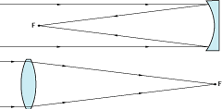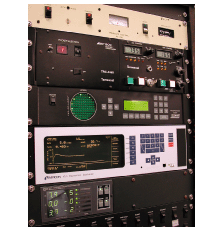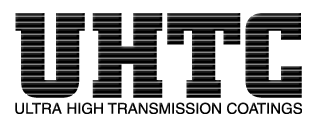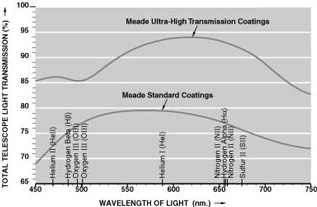| Uma importante opção
para optimizar o desempenho do seu Telescópio Meade.
O brilho da imagem é fundamentalmente dependente
da capacidade de reflexão dos espelhos do telescópio
e da transmissão das suas lentes. Nenhum destes
processos ( capacidade de reflexão dos espelhos
e transmissão das lentes) é, no entanto,
perfeito; ocorrem perdas de luz sempre que ela é
reflectida ou transmitida. O vidro não revestido
reflecte reflecte 4% da luz que incide nele; no caso de
uma lente não revestida a perda é de 4%
à entrada e 4% à saída o que soma
8%...
Os telescópios de 1800 e 1900 sofriam de perdas
de capacidade de reflexão de 50% ou mais. Posteriormente,
os espelhos cobertos a prata incrementaram a reflectividade
mas os custos e a pouca durabilidade eram penosos. Os
modernos revestimentos tem tido sucesso na redução
das perdas atrás referidas com aceitáveis
níveis de preço-qualidade
| Cada vez
que a luz encontra uma superfície de um espelho
(acima) ou duma lente (abaixo), alguma luz se perde.
No caso da lente, perde-se luz à entrada e
também à saída. |
Revestimento Standard Meade: As superfícies
ópticas de todos os telescópios Meade incluem
revestimentos de alta qualidade em consonância com
a qualidade da precisão das próprias ópticas.
Esta cobertura standard, nos espelhos é de alumínio
altamente purificado depositado a vácuo a alta
temperatura e revestido com monóxido de silicone
(SiO); nas lentes o revestimento em ambos os seus lados
para uma transmissão de alta qualidade com fluorito
de magnésio (MgF2). Os revestimentos standard dos
espelhos e lentes Meade igualam ou até superam
a reflectividade ou transmissão qualquer outra
marca oferecida no mercado de telescópios.

| Painel
de controle de um aparelho de revestimento UHTC
a vácuo |
O UHTC: As Tecnologias recentemente desenvolvidas
pela Meade Irvine no campo dos revestimentos e a sua aplicação
através dos mais avançados instrumentos
permitiu evoluir para uma conjugação de
elementos exóticos que levam a uma optimização
dos desempenhos visuais, fotográficos ou de captação
de imagens CCD através dos Telescópios Meade.
O resultado deste trabalho é o UHTC (Ultra-High
Transmission Coatings ) disponível como opção
em muitos dos modelos Meade.
Nos Meade catadióptricos (incluindo os ETX-90EC, ETX-105EC,
and ETX-125EC; LX10, LX90, e LX200GPS Schmidt-Cassegrains;
e LXD55-Series
Schmidt-Newtonians) antes da luz aparecer no foco
passa ou é reflectida em 4 superfícies ópticas:
a parte da frente da lente correctora, a parte de trás
dessa lente, o espelho primário e o espelho secundário.
Cada uma destas superfícies faz perder uma percentagem
de luz maior ou menor consoante o tratamento químico
de cada uma das superfícies e o comprimento de
onda dessa luz. (O tratamento standard do alumínio,
por exemplo,tem a sua maior reflectividade na região
amrela do espectro no comprimento de onda dos 580nm.)
Revestimento de espelhos: Meade ETX, Schmidt-Cassegrain,
and Schmidt-Newtonian telescopes equipped with the Ultra-High
Transmission Coatings group incluem os espelhos primário
e secundário revestidos a alumínio optimizado
com um complexo aglomerado de múltiplas camadas
de dióxido de titanio (TiO2) e dióxido de
silicio (SiO2).A expessura de cada camada é controlada
em +/-1% da espessura óptima. The result is a dramatic
increase in mirror reflectivity across the entire visible
spectrum; at the important hydrogen-alpha wavelength of
656nm. — the predominant wavelength of emission nebulae
— reflectivity is increased from 89% to over 97%.
|

| A special
UHTC label is affixed to the optical tube of the
each Meade telescope equipped with these advanced
coatings. |

| Total
telescope light transmission by wavelength of light.
These graphs show the total amount of light transmitted
to the telescope focus by the four optical surfaces
(primary mirror, secondary mirror, and two lens
surfaces) of Meade ETX, Schmidt-Cassegrain, and
Schmidt-Newtonian telescopes. The wavelengths of the
brightest nebular emission lines are indicated in red.
Meade standard coatings equal or exceed the total light
transmission of virtually all other optical coatings
currently offered in the commercial telescope industry;
notwithstanding this fact, Meade UHTC coatings enable a
dramatic increase in lunar, planetary, and deep-space
image brightness. Note that the graphs presented here
are spectrophotometric results of actual Meade mirrors
and correcting lenses, not theoretical abstractions.
|
Correcting Lens Coatings: Meade telescopes ordered
with the UHTC group include, in addition, an exotic and
tightly-controlled series of coatings on both sides of the
correcting lens or correcting plate, coatings which include
multiple layers of aluminum oxide (Al2O3), titanium dioxide
(TiO2), and magnesium fluoride (MgF2). Per-surface light
transmission of the correcting lens is thereby increased at
the yellow wavelength of 580nm., for example, to 99.8%, versus
a per-surface transmission of 98.7% for the standard coating.
The importance of the UHTC group becomes apparent
when comparing total telescope light transmission, or
throughput, caused by the multiplier, or compounding, effect
of the four optical surfaces. With each optical surface
contributing significantly to telescope light throughput, the
effect of all four surfaces combined is indeed dramatic, as
demonstrated by the graphs on the facing page, as well as by
the table of the brightest nebular emission lines. At the
H-alpha wavelength of 656nm., total transmission increases
from 77% to 93%, an increase of 93/77 or 21% at all three
nitrogen-III and sulfur-II wavelengths of 655nm. and 673nm.—
prominent lines in certain galactic nuclei and in supernova
remnanats such as the Crab Nebula— transmission increases by
21%; ; at the helium wavelengths of 588nm. and 469nm. — strong
emission lines in hot planetary nebulae — total telescope
transmission increases by 18% and 19%, respectively; at the
two nitrogen II lines of 655nm. and 658nm. and at the sulfur
II line of 673nm., transmission is increased by 21%.
Averaged over the entire visible spectrum (450nm. to
700nm.), total light transmission to the telescope focus
increases by about 20%.
Observing with the UHTC: Meade ETX,
Schmidt-Cassegrain, and Schmidt-Newtonian telescopes equipped
with the UHTC present dramatically enhanced detail on the full
range of celestial objects — from emission and planetary
nebulae such as M8,
Emission
Line |
Wave-
length
(nm.) |
Transmission:
Standard
Coatings
(%) |
Transmission:
UHTC
Group
(%) |
Increase* |
Hydrogen-
alpha (Ha) |
656 |
76.9 |
93.1 |
21% |
Hydrogen
beta (Hß) |
486 |
75.3 |
85.8 |
14% |
|
Oxygen III |
496 |
76.5 |
85.4 |
12% |
|
Oxygen III |
501 |
77 |
85.4 |
11% |
|
Helium II |
496 |
72.5 |
86.1 |
19% |
|
Helium I |
588 |
79.5 |
93.5 |
18% |
|
Nitrogen II |
655 |
77 |
93.2 |
21% |
|
Nitrogen II |
658 |
76.7 |
92.8 |
21% |
|
Sulfer II |
673 |
75.7 |
91.8 |
21% | * The % increase is obtained
by dividing the UHTC-transmission (column 4) by the standard
coatings transmission (column 3).
M20, and M57 to star clusters and galaxies such as M3, M13,
and M101. Observations of the Moon and planets, since they are
observed in reflected (white) sunlight, benefit in image
brightness from the full spectrum of increased transmission.
The overall effect of the UHTC is, as it relates to image
brightness, to increase the telescope's effective aperture.
Image brightness (i.e., the ability to see faint detail) of
the Meade 10" LX200GPS is, for example, effectively increased
by about one full inch of aperture.
Effects on CCD Imaging: While the human eye loses
sensitivity to light beyond wavelengths of about 700nm., CCD
imaging chips remain sensitive to about 750nm. and longer,
wavelengths at which the reflectivity of an aluminum coating
is near its lowpoint. Importantly, however, the UHTC's total
light transmission at 750nm. is 83%, vs. 72% for standard
coatings, an increase of 83/72, or 15%.
Ordering the UHTC: The Meade Ultra-High
Transmission Coatings group, if desired, must be specified at
the time of telescope purchase; the UHTC can not be
retrofitted. The UHTC is available for any of these Meade
telescopes:
ETX telescopes: ETX-90EC,ETX-105EC,ETX-125EC
Schmidt-Cassegrains: 8" LX10,8" LX90, 7"
LX200GPS, 8"
LX200GPS, 10" LX200GPS,12"
LX200GPS, 16"
LX200GPS
LXD55 Schmidt-Newtonians: 6"
Model SN-6, 8" Model SN-8,10" Model SN-10
|